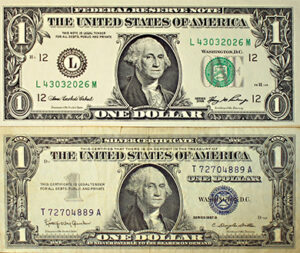- Explain what money is
- Explain why money is important
- Identify alternatives to traditional currency
All About Money
You probably have a significant interest in money. One of the reasons that you’re taking this course is likely that you hope to find a better job that pays well enough to improve your life. Understanding what money is and how it functions is the first step in understanding our complex financial system and how it affects you.
What Is Money?
money
Money is anything that people use to pay for goods and services and to pay people for their work.
Historically, money has taken different forms in different cultures—everything from salt, stones, and beads to metal coins, and, more recently, virtual currency. Whatever form it takes, money needs to be widely accepted by both buyers and sellers in order to be useful.
Barter and the Double Coincidence of Wants
To understand the usefulness of money, think about what the world would be like without money. How would people exchange goods and services? Economies without money typically use barter.
barter
Barter is literally trading one good or service for another. In an economy without money, an exchange between two people would involve a double coincidence of wants, a situation in which two people each want some good or service that the other person can provide.
If a hairstylist wants a pair of shoes, they must find a shoemaker who has a pair of shoes in the correct size and who is willing to exchange the shoes for a certain number of haircuts. Such a trade is probably difficult to arrange. Barter is a highly inefficient method to use for trading in a modern, advanced economy. Imagine the difficulty of a business owner who needs to obtain raw materials, have those materials delivered, and have employees use the materials to manufacture a product. The business owner would need to be able to offer so many different goods and services to barter for all those things and compensate workers. Then rather than selling their product for money, they’d have to find customers that have desirable goods and services to trade. Money makes running a business much easier.
Another problem with the barter system is that it doesn’t allow people to easily enter into future trades. For example, if the goods are perishable, it may be difficult to exchange them for other goods in the future. Imagine a farmer who wants to buy a tractor in six months but only has a fresh crop of strawberries to trade now. Also, while the barter system might work adequately in small economies, it will limit growth. Specifically, time that individuals might otherwise spend producing goods and services and enjoying leisure time is spent bartering.
Commodity Versus Fiat Money
commodity money
Commodity money consists of objects that have their own value in addition to their use as money.

Gold, for example, has been used throughout the ages as money, although today it is not used as money but rather is valued for its other attributes. Gold is a good conductor of electricity and is used in the electronics and aerospace industry. Gold is also used in the manufacturing of energy-efficient reflective glass for skyscrapers and is used in the medical industry as well. Of course, gold also has value because of its beauty and malleability in the creation of jewelry.
During much of its history, the money supply in the United States was backed by gold and silver. Interestingly, antique dollars dated as late as 1957 have “Silver Certificate” printed above the portrait of George Washington, as shown below. This meant that the holder could take the bill to the appropriate bank and exchange it for a dollar’s worth of silver.

As economies grew and became more global in nature, the use of commodity monies became more cumbersome. Countries moved toward the use of fiat money.
fiat money
Fiat money is a type of currency that has no intrinsic value and is not backed by a physical commodity, such as gold or silver. Fiat money’s value comes from the backing of the government that issued it.
For example, the United States’ paper money, like a dollar bill, carries the statement, “This note is legal tender for all debts, public and private.” In other words, by government decree, if you owe a debt, then you can pay that debt with the U.S. currency. The piece of paper that the dollar bill is printed on is not valuable on its own the way that gold is. The value of U.S. currency comes from the widespread trust that the U.S. government stands behind its currency.